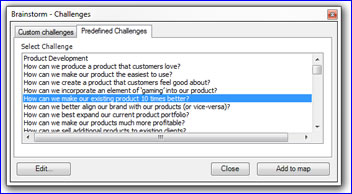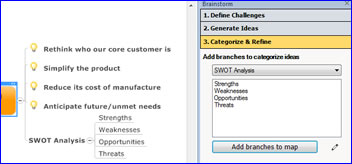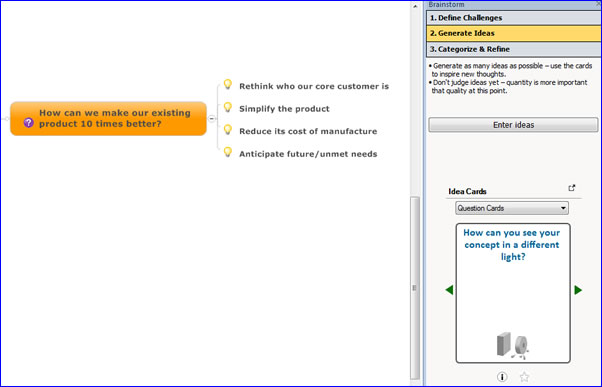I’ve always been a fan of theRealizer, a brainstorming plug-in for MindManager (read my review of it from 2008 here). So when I learned that Mindjet integrated this terrific process-driven brainstorming tool into MindManager 2012, I was very excited. So I asked Michael Deutch at Mindjet to give me a deeper dive into how they expanded and improved it. Much has changed, which is why we’re going to take a closer look at it.
Deutch emphasized that Mindjet’s development team worked closely with the Realize AB, the Swedish company who developed theRealizer. This company specializes in doing facilitated brainstorming sessions, and Mindjet wanted to be sure to leverage their expertise to make this the best possible ideation tool for business users.
This brainstorming tool consists of three stages:
1. Define challenge
It’s been said that a problem clearly defined is already half solved. Accordingly, the challenge phase of this brainstorming tool helps you to accurately define the problem or challenge for which you want to brainstorm ideas. The program ships with a set of over 60 predefined challenge statements, categorized into product development, marketing, sales, organization and individual categories. theRealizer add-in only contained nine challenge cards, so this is a major expansion.
Adding a challenge to your mind map is simple: Select one statement and click the “add to map” button. The idea here is that once you’ve added your challenge statement to the map, you then add topics and sub-topics to it where you explore how to address your challenge. Sometimes, this deep exploration of your challenge can reveal a deeper problem that you didn’t realize existed. Perhaps you were trying to solve the wrong problem. Or it may lead to some useful ideas, even before you get to the actual brainstorming stage.
 If you want to modify the wording of an existing challenge statement or add your own to the set that MindManager 2012’s brainstorming tool displays each time you use it, you simply click on the “edit” button. The challenge list becomes editable text, and you can delete, add, modify or regroup challenges with complete freedom.
If you want to modify the wording of an existing challenge statement or add your own to the set that MindManager 2012’s brainstorming tool displays each time you use it, you simply click on the “edit” button. The challenge list becomes editable text, and you can delete, add, modify or regroup challenges with complete freedom.
If you want to create your own challenge, a separate “custom challenge” tab gives you fields to enter your own challenge statement and some notes about it. The note becomes a topic note attached to your challenge topic, as you would expect.
The challenges section of this brainstorming tool also contains a visual element: Over 600 challenge cards, which look something like cards you’d expect to find in a deck of playing cards. Each challenge card contains an image and a statement – such as “Describe a picture of success. What do you need to get there?” with a picture of a set of legs and feet standing in first place on the winner’s stand after an athletic event. Clicking on an information button below the card “flips” it over and displays a suggestion on how to utilize its message. Cards can also be designated as favorites by clicking on a star icon. Once you’ve selected one or more cards as favorites, a separate set of navigation arrows appears on screen, enabling you to browse only your favorite challenge cards.
One neat enhancement that Mindjet made for MindManager 2012 was to enable users to increase the size of the challenge cards on screen. The cards can be opened in a separate window, which displays them at roughly twice the normal size. This is useful for anyone who is facilitating a group brainstorming session or web-based meeting, so that their text can be clearly viewed on screen.
2. Generate ideas
When they adapted theRealizer to MindManager 2012, the developers at Mindjet modified the idea entry form to enable quick entry. When you click on the “enter ideas” button, a dialog box pops up, where you can quickly type your ideas, hit the enter key and immediately type your next idea. I tried it, and it was very fast! This is ideal for group brainstorming sessions, where ideas are often flying fast, and you need to be able to record them just as quickly.
This stage of the brainstorming process contains three types of cards:
Questions: These cards are based on SCAMPER, a brainstorming technique that asks you to perform different actions on your idea – for example, minimize it, put it to other uses or rearrange its parts. SCAMPER is one of the world’s best known and most proven brainstorming techniques, so it’s good to see it here.
Images: Image cards contain a question and an image. They appeal to a different part of the brain, and encourage users to engage in out of the box thinking.
Words: Word cards, as their name implies, contain a single word. They function as random thinking prompts, and should lead your creative problem solving efforts in new directions. MindManager 2012 contains 500 word-based idea cards, substantially more than theRealizer did.
Idea cards follow a similar format to the challenge cards, with the ability to display them in a larger format in a separate window and to designate cards as favorites and then navigate them easily. theRealizer enabled users of this plug-in to edit these cards, but Mindjet decided to eliminate this feature to keep things easier for users.
3. Categorize and refine
 By the time you reach this stage, your mind map should now be full of ideas. Your next step is to organize and improve them. MindManager 2012 enables you to create 4 types of branches to categorize your ideas: Do it!, Investigate, Save, Trash. The idea behind this scheme is that you add these smart topics to your map and then drag and drop the ideas you’ve generated to them.
By the time you reach this stage, your mind map should now be full of ideas. Your next step is to organize and improve them. MindManager 2012 enables you to create 4 types of branches to categorize your ideas: Do it!, Investigate, Save, Trash. The idea behind this scheme is that you add these smart topics to your map and then drag and drop the ideas you’ve generated to them.
MindManager 2012’s brainstorming tool also contains four different tools for further refining and classifying ideas:
- Idea refinement terms
- Opportunities
- SWOT analysis (strengths/weaknesses/opportunities/threats)
- Time management
Selecting one of these evaluation tools adds all of its associated keywords to your mind map as a group. An edit button opens up a dialog box that enables you to modify the five existing idea improvement methods or add your own. This could be very useful if your firm has a standard procedure or set of criteria-based screens for evaluating ideas. You could include them in this toolset, or eliminate the pre-installed ones and just present your organization’s proprietary method.
Conclusion
Mindjet has made impressive improvements to this brainstorming tool, and has integrated it tightly into MindManager 2012. In the past, a lot of people made claims that mind mapping was an excellent creative tool. Now that’s true in spades, thanks to this refined and expanded toolset in the latest version of MindManager.
Why have I spent so much time analyzing this brainstorming tool? Because creative ideas are more important than ever today. There are many brainstorming tools and techniques available to you today, but most of them only do one thing – serve as a catalyst to help you generate ideas. What I like about this tool is the fact that it wraps an entire process around the act of brainstorming – from clearly defining your challenge to refining and evaluating your ideas, so you can quickly identify the best ones for implementation (and which then can be managed as projects within the same software program!).


Leave a Reply